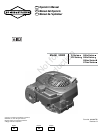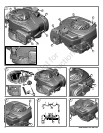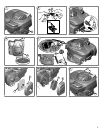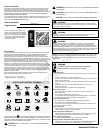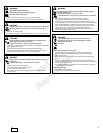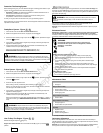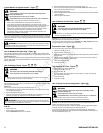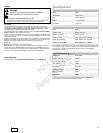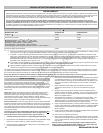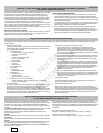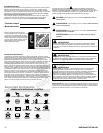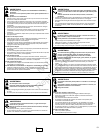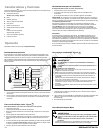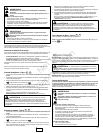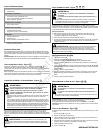
8
BRIGGSandSTRATTON.COM
Inspect Muffler And Spark Arrester - Figure
1
Running engines produce heat. Engine parts, especially muffler,
become extremely hot.
Severe thermal burns can occur on contact.
Combustible debris, such as leaves, grass, brush, etc. can catch fire.
WARNING
Allow muffler, engine cylinder and fins to cool before touching.
Remove accumulated debris from muffler area and cylinder area.
It is a violation of California Public Resource Code, Section 4442, to useor
operate the engineon anyforest-covered,brush-covered,or grass-covered land
unless the exhaust system is equipped with a spark arrester, as defined in
Section 4442, maintained in effective working order. Other states or federal
jurisdictions may have similar laws. Contact the original equipment
manufacturer, retailer, or dealer to obtain a spark arrester designed for the
exhaust system installed on this engine.
Remove accumulated debris from muffler area and cylinder area. Inspect the muffler (H,
Figure 1) forcracks, corrosion, orother damage. Remove thespark arrester, if equipped,
and inspectfor damageorcarbon blockage. Ifdamage isfound, installreplacement parts
before operating.
WARNING: Replacement parts must be of the same design and installed
in the same position as the original parts. Other parts may not performas well, may
damage the unit, and may result in injury.
How To Replace The Spark Plug - Figure
8
Check the gap (A, Figure 8) with a wire gauge (B). If necessary, reset the gap. Install
and tightenthe sparkplug totherecommended torque.For gap settingor torque,see the
Specifications section.
Note: In some areas, local law requires using a resistor spark plug to suppress ignition
signals. If this engine was originally equipped with a resistor spark plug, use the same
type for replacement.
How To Change The Oil - Figure
9 10 11
WARNING
Fuel and its vapors are extremely flammable and explosive.
Fire or explosion can cause severe burns or death.
When you drain the oil from the top oil fill tube, the fuel tank must be empty or
fuel can leak out and result in a fire or explosion.
Used oil is a hazardous waste product and must be disposed of properly. Do not discard
with householdwaste. Check with yourlocal authorities,service center, or dealerfor safe
disposal/ recycling facilities.
Remove Oil
The oil must be drained from the top oil fill tube (E, Figure 10).
1. With engine off but still warm, disconnect the spark plug wire (A) and keep it away
from the spark plug (Figure 9).
2. Remove the dipstick (G, Figure 11).
3. When you drain the oil from the top oil fill tube (E), keep the spark plug end of the
engine (F) up (Figure 10). Drain the oil into an approved container.
WARNING: When you drain the oil from the top oil fill tube, the fuel tank
must be empty or fuel can leak outand result in a fire or explosion. To empty the fuel
tank, run the engine until it stops from lack of fuel.
Add Oil
Place engine level.
Clean the oil fill area of any debris.
See the Specifications section for oil capacity.
1. Remove the dipstick (G) and wipe with a clean cloth (Figure 11).
2. Pour the oil slowly into the engine oil fill (H). Do not overfill. After adding oil, wait
one minute and then check the oil level.
3. Install and tighten the dipstick.
4. Remove thedipstick andcheck the oillevel. Itshould be at thetop of the fullindicator
(J) on the dipstick.
5. Install and tighten the dipstick.
How To Service The Air Filter - Figure
12 13
WARNING
Fuel and its vapors are extremely flammable and explosive.
Fire or explosion can cause severe burns or death.
Never start or run the engine with the air cleaner assembly (if equipped) or the
air filter (if equipped) removed.
NOTICE: Do not use pressurized air or solvents to clean the filter. Pressurized air can
damage the filter and solvents will dissolve the filter.
Two types of air filter systems are shown, a Standard and a High Capacity. Determine
the type installed on your engine and service as follows.
Standard Air Filter - Figure
12
The air cleaner system uses a foam element that can be washed and reused.
1. Open the cover (B, Figure 12).
2. Remove the foam element (C).
3. Washthe foam element inliquid detergent and water. Squeezedry the foamelement
in a clean cloth.
4. Saturate the foam element with clean engine oil. To remove the excess engine oil,
squeeze the foam element in a clean cloth.
5. Install the foam element (C).
6. Close the cover (B).
High Capacity Air Filter - Figure
13
The air cleaner system uses a pleated filter.
1. Open the cover (B, Figure 13).
2. Remove the filter (D).
3. To loosen debris, gently tap the filter on a hard surface. If the filter is excessively
dirty, replace with a new filter.
4. Install the filter (D).
5. Close the cover (B).
How To Clean The Air Cooling System - Figure
14
Running engines produce heat. Engine parts, especially muffler,
become extremely hot.
Severe thermal burns can occur on contact.
Combustible debris, such as leaves, grass, brush, etc. can catch fire.
WARNING
Allow muffler, engine cylinder and fins to cool before touching.
Remove accumulated debris from muffler area and cylinder area.
NOTICE: Do not use water to clean the engine. Water could contaminate the fuel
system. Use a brush or dry cloth to clean the engine.
This is an air cooled engine. Dirt or debris can restrict air flow and cause the engine to
overheat, resulting in poor performance and reduced engine life.
Use a brush or dry cloth to remove debris fromthe finger guard (A). Keep linkage,
springs and controls (B) clean. Keep the area around and behind themuffler (C)freeof
any combustible debris (Figure 14).
Not for
Reproduction



